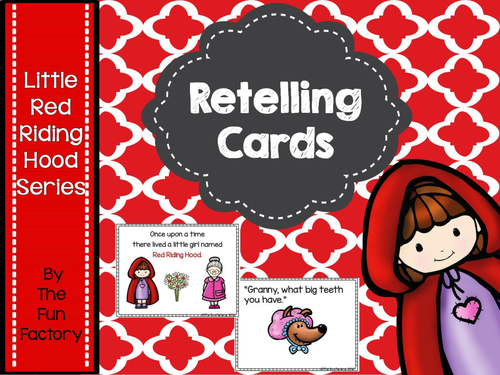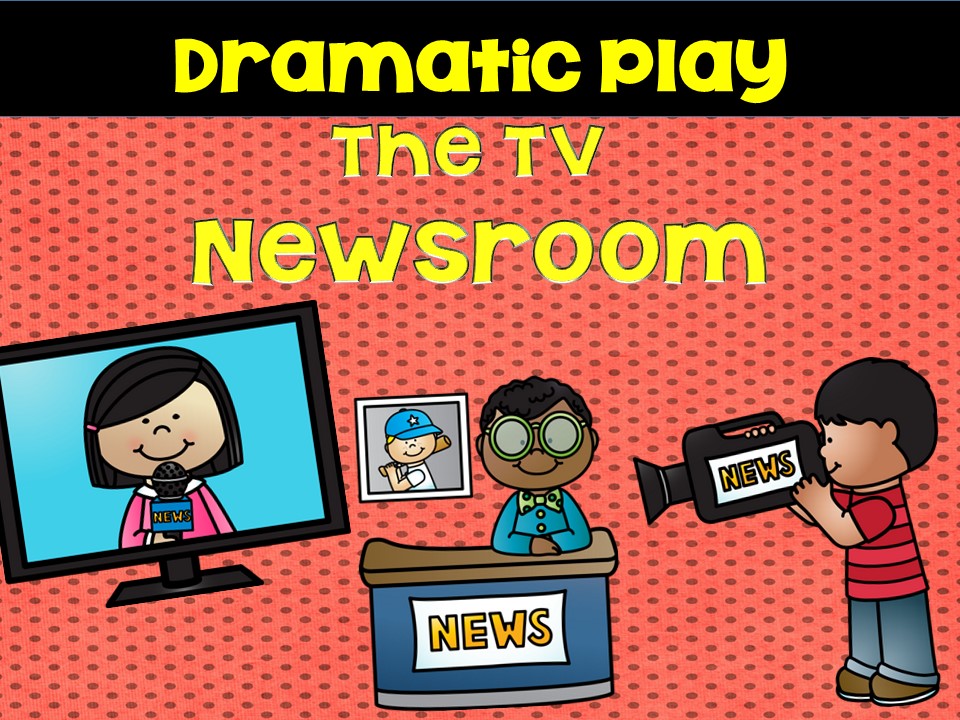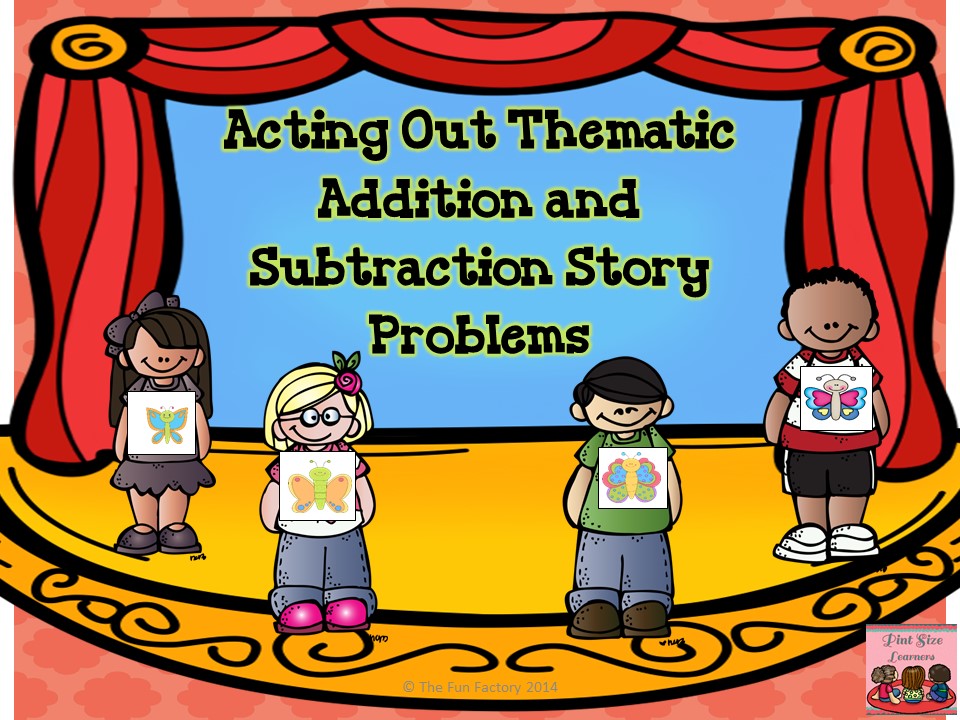
13Uploads
4k+Views
97Downloads
All resources

Retelling Little Red Riding Hood
Retelling a story is a very important comprehension skill and one that our young students need a lot of practice with. To scaffold their success at this skill, read familiar fairy tales aloud and let them retell them. These retelling cards provide visual clues to help your little ones. This is a whole group activity that can be placed in a center after everyone knows the sequence of the story.

Dramatic Play ~ The TV Newsroom
Authentic reading and writing are an part of this dramatic play set. Children have a meaningful purpose to use print. The dramatic play center is also an area in the room where conversation is a must! Children should be encouraged to use the vocabulary of the theme as they interact with the props and each other.
This packet includes forms and printables for The Newsroom at the dramatic play center.
This theme contains:
• A Lap Book ~ for reading aloud, that introduces the children to the specific vocabulary for the unit
• Name Badges ~ for the people that work at the TV station
• Various Forms
• Thematic Word Cards
• Cue Cards
• “Weather Maps”
• Suggestions For Additional Props

No Prep Rhyming
Welcome your PK and Kindergarten students back to school with these no prep fun foldable books. Students look for something on each page that rhymes with the picture on the cover.
Use the information gathered from their responses as a formative assessment to guide your phonological awareness activities in small group.

No Prep Concept Matching
Welcome your PK and Kindergarten students back to school with these no prep fun worksheets. Students look at the pictures on the page and color the ones that belong together. ( Color the things: that you see at home, that you see at school, that you see at the beach, that are red, that are hot, that are square, etc.)
Use the information gathered from their responses to guide your vocabulary development lessons.
You can assess if your students are familiar with letters, numbers, animals, size, colors, shapes and more.

Reading Response Questions ~ First and Second Grades
This packet includes a total of 84 reading task cards (color and black and white) for your students to use with their independent reading books. During literacy centers, students find and write specific words from their books based on the task card instructions.
There are:
10 cards for finding sight word or word wall words in their book
10 cards for working with comprehension (story elements, real/make believe, fact/opinion , etc.)
10 cards for grammar (nouns, verbs, pronouns, contractions, compound words, antonyms, synonyms etc.)
54 cards for phonics ( short vowel sounds long vowel sounds, vowel pairs, r controlled vowels, beginning blends and ending digraphs)

Consumers and Producers ~ Economics for 1st and 2nd Grades
Your students will have fun matching and sorting as they find out what the difference is between a consumer and a producer, and goods and services. We have included word wall cards, writing task cards and a research template to extend their learning. This 41 page unit includes the following:
• Posters
Producers, Services, Goods, Consumers
• Sort
People Who Provide Goods And People Who Provide Services – cards, mats and response sheet
• Matching
Producers With Goods They Produce – cards and response sheet
• Matching
People Who Work In The Community With Where They Work - cards and response sheet
• An Interactive Book
What Goods Will I Use Today?
• Matching
Goods With The Consumers - cards and a response sheet
• Word Wall Cards
• Writing Task Cards
• Research Timeline Template

CCVC Word Work ~ K-1
Are your students working on beginning blends? Here are 5 CCVC word activities that will allow them to have fun practicing this standard. This CCVC unit contains activities that can be used in whole group, small group or centers. All activities use the same 24 pictures to make it easier for your students to work independently. Response sheets are included to provide the students the opportunity to write the initial consonant blends.
The activities include:
24 CCVC Puzzles
24 CCVC Clip-It Cards
Worksheets
Interactive CCVC
CCVC at the Pocket Chart
Initial consonant blends included are:
• cl
• sl
• fl
• tw
• pl
• cr
• gr
• fr
• dr
• sp
• sw
• st
• tr
Common Core State Standards practiced with this unit are:
CCSS.ELA-Literacy.RF.K.1a Follow words from left to right, top to bottom, and page by page.
CCSS.ELA-Literacy.RF.K.1b Recognize that spoken words are represented in written language by specific sequences of letters.
CCSS.ELA-Literacy.RF.K.1d Recognize and name all upper- and lowercase letters of the alphabet.
CCSS.ELA-Literacy.RF.1.2b Orally produce single-syllable words by blending sounds (phonemes), including consonant blends.
CCSS.ELA-Literacy.RF.1.2c Isolate and pronounce initial, medial vowel, and final sounds (phonemes) in spoken single-syllable words.
CCSS.ELA-Literacy.RF.1.2d Segment spoken single-syllable words into their complete sequence of individual sounds (phonemes).

Vowel Pairs
Help your first or second grade students decode words in context and in isolation by applying common letter-sound correspondences, to these vowel digraphs oo as in foot, oo as in moon, ea as in eat, ea as in bread, ee, ow as in how, ow as in snow, ou as in out, ay, ai, aw, ew, oa, ie as in chief, ie as in die, and –igh. Each vowel pair has 3 different activities in this 55 page phonics unit.
• The first activity is a print and go activity sheet where your students read a sentence containing a word with the specific vowel pair, then cut and paste a corresponding picture.
• The second activity is a word sort, complete with sorting mats and word cards. We have included a response sheet so they can record their sorts.
• The third activity is a booklet for each vowel pair for your students to fold and make and then write the specified words.
This unit is great for whole group, small group and independent practice at literacy centers.

Counting Practice 1-12 ~ Center Activities and Worksheets
Learning to count means learning that there is a sequence to the numbers. Kindergarteners should be able to count to 12, and identify the larger of two numbers. Their concept of one to one correspondence grows stronger
We have developed this series of math skills packets to give our children practice with foundational math skills.
Help your students work independently with this counting center. Included are:
• clip cards
• puzzles
• counting objects and counting mats
• number order activity
• 3 number matching mats
• dot to dot sheets
• counting 1-12 booklet

Recognizing Numbers 1-12 ~ Center Activities and Worksheets
Kindergarteners learn to recognize numbers to 12. which requires strong visual discrimination skills since many numerals (6 and 9, or 3 and 8) look like each other. After the child is able to recognize the numbers and he knows each number’s name, he can develop an understanding of the amount each number represents.
We have developed this series of math skills packets to give our children practice with foundational math skills.
Help your students work independently with this counting center. Included are:
• Sorting numbers and letters
• 2 Matching numbers activities
• Number puzzles
• Worksheets
• Recognizing numbers booklet

Number Sense 1-12 ~ Center Activities and Worksheets
Young children need to learn that 5 means a set of 5 objects no matter their size. They should learn to compose and decompose numbers. They should be able to tell the quantities of a set of objects without counting.
We have developed this series of math skills packets to give our children practice with foundational math skills.
Help your students work independently with this counting center. Included are:
• 3 matching activities
• Puzzles
• Number order activity
• Worksheets
• Number sense booklet

CVC Word Families
What’s in your tent?
Each tent is a sorting mat with a different CVC word family. Students add picture letter cards that will make a word when combined with the specified word family.
Rime Sorts
is another center activity where the students sort pictures with the same rime onto letter mats.
Clip –It Cards
is a center activity where the students put clips on the pictures that are in a specified word family.
6 worksheets
reviewing the word families, are also included.

Addition and Subtraction Word Problem Necklaces for PK/K
Want an easy and fun way for your students to see numbers grow or shrink when adding or subtracting? Have your students “become” these story problems! Each story has 5 necklaces to be worn by the students, a sample story and an activity to extend into centers.
Included are 12 sets ( a whole year's worth) of necklaces to go along with 12 stories. As you read the short story, the students either join or leave the group of actors. The topics include:
• How Many Apples
• How Many Crayons
• How Many Leaves
• How Many Pumpkins
• How Many Turkeys
• How Many Reindeer
• How Many Snowmen
• How Many Hearts
• How Many Leprechauns
• How Many Kites
• Counting Seeds
• How Many Butterflies
Additional worksheets are included. Below is a sample story for How Many Snowmen.
One snowy day 2 snowmen were standing in the front yard. Jeff and Amy came outside and built 2 more snowmen. How many snowmen are there now?
The next day the sun came out and 2 of the snowmen melted. How many snowmen are there now? Are the numbers getting larger or smaller?
The next day it snowed again and Amy made 1 more snowman. How many snowmen are there now?
The next day Jeff made 2 more snowmen. How many snowmen are there now?
When the sun came back the snow melted and all the snowmen melted. How many snowmen are there now?
You can make up your own stories to make every experience with the story problem necklaces different and fun!
Black and white version included - 213 pages













